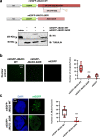JMJD3 intrinsically disordered region links the 3D-genome structure to TGFβ-dependent transcription activation
- PMID: 35672304
- PMCID: PMC9174158
- DOI: 10.1038/s41467-022-30614-y
JMJD3 intrinsically disordered region links the 3D-genome structure to TGFβ-dependent transcription activation
Abstract
Enhancers are key regulatory elements that govern gene expression programs in response to developmental signals. However, how multiple enhancers arrange in the 3D-space to control the activation of a specific promoter remains unclear. To address this question, we exploited our previously characterized TGFβ-response model, the neural stem cells, focusing on a ~374 kb locus where enhancers abound. Our 4C-seq experiments reveal that the TGFβ pathway drives the assembly of an enhancer-cluster and precise gene activation. We discover that the TGFβ pathway coactivator JMJD3 is essential to maintain these structures. Using live-cell imaging techniques, we demonstrate that an intrinsically disordered region contained in JMJD3 is involved in the formation of phase-separated biomolecular condensates, which are found in the enhancer-cluster. Overall, in this work we uncover novel functions for the coactivator JMJD3, and we shed light on the relationships between the 3D-conformation of the chromatin and the TGFβ-driven response during mammalian neurogenesis.
© 2022. The Author(s).
Conflict of interest statement
The authors declare no competing interests.
Figures







Similar articles
-
Spatial genome organization, TGFβ, and biomolecular condensates: Do they talk during development?Bioessays. 2022 Dec;44(12):e2200145. doi: 10.1002/bies.202200145. Epub 2022 Oct 17. Bioessays. 2022. PMID: 36253122 Review.
-
Lineage specific transcription factors and epigenetic regulators mediate TGFβ-dependent enhancer activation.Nucleic Acids Res. 2018 Apr 20;46(7):3351-3365. doi: 10.1093/nar/gky093. Nucleic Acids Res. 2018. PMID: 29438503 Free PMC article.
-
Super enhancers-Functional cores under the 3D genome.Cell Prolif. 2021 Feb;54(2):e12970. doi: 10.1111/cpr.12970. Epub 2020 Dec 17. Cell Prolif. 2021. PMID: 33336467 Free PMC article. Review.
-
Increased enhancer-promoter interactions during developmental enhancer activation in mammals.Nat Genet. 2024 Apr;56(4):675-685. doi: 10.1038/s41588-024-01681-2. Epub 2024 Mar 20. Nat Genet. 2024. PMID: 38509385 Free PMC article.
-
Activation of neuronal gene expression by the JMJD3 demethylase is required for postnatal and adult brain neurogenesis.Cell Rep. 2014 Sep 11;8(5):1290-9. doi: 10.1016/j.celrep.2014.07.060. Epub 2014 Aug 28. Cell Rep. 2014. PMID: 25176653 Free PMC article.
Cited by
-
JmjC Family of Histone Demethylases Form Nuclear Condensates.Int J Mol Sci. 2022 Jul 11;23(14):7664. doi: 10.3390/ijms23147664. Int J Mol Sci. 2022. PMID: 35887017 Free PMC article.
-
Epigenetics and environmental health.Front Med. 2024 Aug;18(4):571-596. doi: 10.1007/s11684-023-1038-2. Epub 2024 May 28. Front Med. 2024. PMID: 38806988 Review.
-
Dynamic microenvironments shape nuclear organization and gene expression.Curr Opin Genet Dev. 2024 Jun;86:102177. doi: 10.1016/j.gde.2024.102177. Epub 2024 Mar 10. Curr Opin Genet Dev. 2024. PMID: 38461773 Free PMC article. Review.
-
Super-enhancers: drivers of cells' identities and cells' debacles.Epigenomics. 2024 Apr 8;16(9):681-700. doi: 10.2217/epi-2023-0409. Online ahead of print. Epigenomics. 2024. PMID: 38587919 Free PMC article. Review.
-
Liquid condensates: a new barrier to loop extrusion?Cell Mol Life Sci. 2025 Feb 20;82(1):80. doi: 10.1007/s00018-024-05559-8. Cell Mol Life Sci. 2025. PMID: 39976773 Free PMC article. Review.
References
Publication types
MeSH terms
Substances
LinkOut - more resources
Full Text Sources
Molecular Biology Databases

